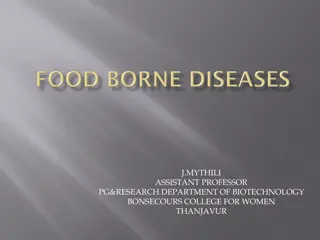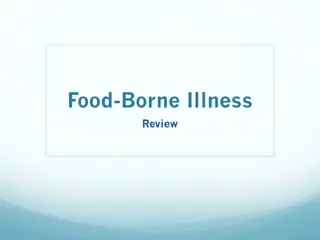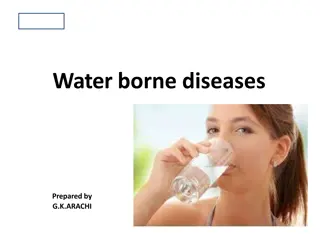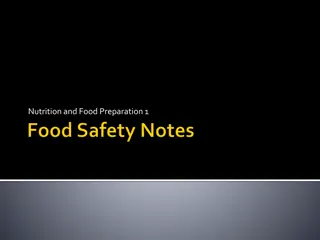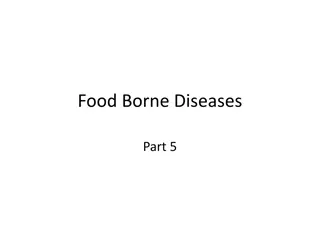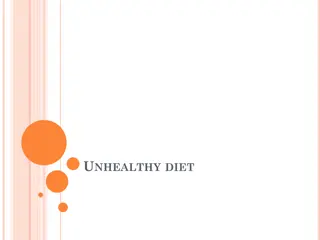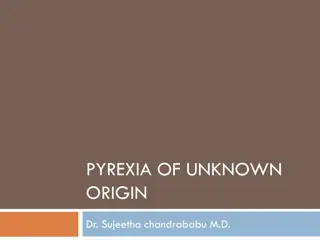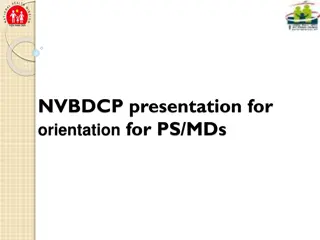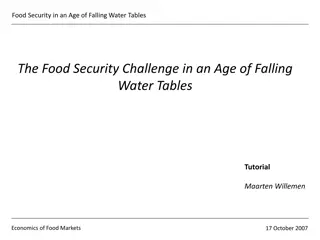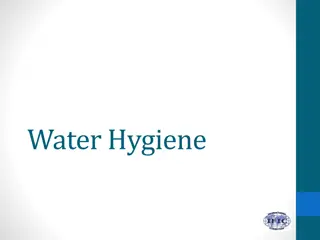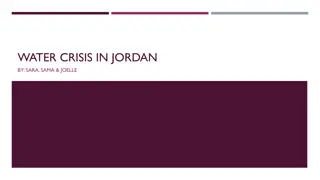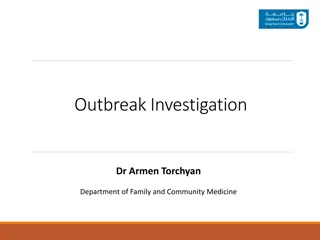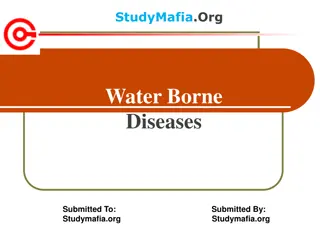Understanding Food and Water-Borne Diseases: Causes and Classification
Food and water-borne diseases, caused by contaminated food or water, lead to acute illnesses. These diseases are classified into food-borne infections and food-borne intoxications. Food-borne infections, triggered by pathogenic microorganisms, can be fungal, bacterial, viral, or parasitic, with long incubation periods and fever as common symptoms. Salmonellosis, caused by various salmonella serotypes, is a notable example of a food-borne infection.
- Food-borne diseases
- Water-borne diseases
- Contaminated food
- Disease classification
- Pathogenic microorganisms
Download Presentation

Please find below an Image/Link to download the presentation.
The content on the website is provided AS IS for your information and personal use only. It may not be sold, licensed, or shared on other websites without obtaining consent from the author. Download presentation by click this link. If you encounter any issues during the download, it is possible that the publisher has removed the file from their server.
E N D
Presentation Transcript
FOOD AND WATER BORN DISEASES Mr. RAJENDRA SINGH AXON|BIO Network
FOOD AND WATER BORN DISEASES 2 SYNOPSIS - 1. INTRODUCTION 2. CLASSIFICATION Food borne infections and Food borne intoxications 3. REFERENCES
FOOD AND WATER BORN DISEASES 3 Food borne diseases Food borne diseases (FBD) are acute illnesses associated with the recent consumption of food. The food involved is usually contaminated with a disease pathogen or toxicant. Such food contains enough pathogens or toxicant necessary to make a person sick.
FOOD AND WATER BORN DISEASES 4 Classification of food borne diseases Food borne diseases are classified into: 1. Food borne infections and 2. Food borne intoxications
FOOD AND WATER BORN DISEASES 5 Food borne infections Food borne infections are caused by the entrance of pathogenic microorganisms contaminating food into the body, and the reaction of the body tissues to their presence. These can either be fungal, bacterial, viral or parasitic. Food borne infections tend to have long incubation periods and are usually characterized by fever.
FOOD AND WATER BORN DISEASES 6 Food Borne Infections cont.. Bacterial food borne infections include Cholera, salmonellosis, typhoid fever, shigellosis, Yersiniosis Escherichia coli infection Campylobacteriosis, Vibrio parahemolyticus and Listeriosis. Mycotic food borne infections include Candida spp., Sporothrix spp., Wangiella spp. etc), Viral food borne infections include hepatitis A , Norwak virus and poliomyelitis virus.
FOOD AND WATER BORN DISEASES 7 Salmonellosis The salmonellae constitute a group of organisms with over 2000 different serotypes. These organisms are capable of causing disease in animals and man when taken into the body in sufficient numbers. Many salmonella species have a wide host range. These are the organisms which commonly cause food poisoning.
FOOD AND WATER BORN DISEASES 8 Salmonellosis However, some are restricted to a single host species e.g. Salmonella abortus ovis causing abortion in ewes, and Salmonella gallinarum the cause of fowl typhoid. Conversely, some salmonella serotypes are associated with human disease and are not known to affect animals e.g. S. typhi. and Salmonella paratyphi. Salmonellae are ubiquitous in the gut of human and animals and act as sources of food contamination.
FOOD AND WATER BORN DISEASES 9 Common food poisoning serotypes Some of the salmonella species involved in food poisoning include; Salmonella typhimurium, Salmonella enteritidis, Salmonella dublin, Salmonella softenburg, Salmonella virchow, Salmonella montevideo, Salmonella infantis, and salmonella newport. These species are also involved in causing diarrhoea in animals.
FOOD AND WATER BORN DISEASES 10 Factors associated with Salmonella food poisoning outbreaks Consumption of inadequately cooked or thawed meat or poultry. Cross-contamination of food from infected food handlers. Presence of flies, cockroaches, rats, in the food environment that act as vectors of the disease.
FOOD AND WATER BORN DISEASES 11 Transmission Salmonellae reach food in many different ways; a) Directly from slaughter animals to food. b) From human excreta, and transferred to food through hands, utensils, equipments, flies etc. Food poisoning is more likely to occur if the total number of microorganisms present is high. A smaller number may have no ill effect.
FOOD AND WATER BORN DISEASES 12 Foods involved Any food contaminated with salmonellae may be involved. However, foods commonly involved are animal derived foods such as: a. meat and meat products, b. milk and milk products, c. egg and egg products
FOOD AND WATER BORN DISEASES 13 Clinical symptoms The ordinary symptoms include abdominal pain, headache, diarrhea, fever, vomiting,, prostration and malaise. In severe cases there is septicaemia with leucopenia, endocarditis, pericarditis. Severe cases are encountered in babies, young children , the sick and in elderly persons. The mortality is upto 13 %.
FOOD AND WATER BORN DISEASES 14 Control measures Efficient refrigeration and hygienic handling of food. Consumption of properly cooked meat. Complete thawing of frozen meats and adequate cooking. Heat processing of meat, milk , fish and poultry to destroy salmonella organisms in food.
FOOD AND WATER BORN DISEASES 15 Typhoid and Paratyphoid fever (Enteric fevers) Enteric fevers include typhoid and paratyphoid fevers caused by Salmonella typhi and Salmonella paratyphi A, B and C respectively. The serotypes are similar to other salmonella bacteria, but unlike them, they are essentially parasites of man. S. typhi possesses capsular (vi). antigen in addition to the usual O and H antigens found in other serotypes.
FOOD AND WATER BORN DISEASES 16 Disease symptoms The incubation period is usually 2 weeks, but might vary between 3 and 28 days for typhoid fever and between 1 and 15 days for the paratyphoid fevers. The enteric fevers are generalized septicaemic infections with a frequent, if not constant bacteraemia during the first two weeks of the disease. The abdominal symptoms are severe, while fever and illness may continue for 4-6 weeks.
FOOD AND WATER BORN DISEASES 17 Transmission The typhoid and paratyphoid bacilli are essentially human parasites and are acquired mostly from human sources, namely, patients and carriers. The bacteria can be transmitted by the contamination of water, milk or food by flies. Only a few organisms are needed to cause disease.
FOOD AND WATER BORN DISEASES 18 Control measures Hygienic control of food and water supplies Detection and treatment of chronic carriers Vaccination using TAB-vaccine. The vaccine contains a mixed culture of S. typhi, and S. paratyphi. The vaccine protects for 5-7 yrs.
FOOD AND WATER BORN DISEASES 19 Campylobacteriosis Campylobacter are a group of tiny strictly micro-aerophilic curved or spiral gram negative rods Campylobacter jejuni and Campylobacter coli cause food poisoning and are associated with acute enterocolitis in man. Campylobacter jejuni occur in large numbers in cattle feces, and poultry as normal flora. Campylobacter coli are commonly associated with human diarrhoea, and enteritis in pigs mostly in association with Treponema hyodysenteriae.
FOOD AND WATER BORN DISEASES 20 Disease in man Campylobacter jejuni and C. coli cause illness characterized by diarrhoea, abdominal pain, fever, nausea, vomiting, and abdominal complaints. The jejunum, ileum and colon are primarily affected resulting in acute inflammation and occasionally, abscess formation. The disease is self-limiting.
FOOD AND WATER BORN DISEASES 21 Clinical signs Incubation period ranges between 2-11 days with an average of 3-5 days. It is preceded by fever, followed by foul smelling and watery diarrhea, which runs for 3-4 days. Thediarrhea may sometimes contain blood and mucus in feces. Abdominal pain is associated with backache, and a high mortality. The condition is self-limiting but may last for up to 10 days.
FOOD AND WATER BORN DISEASES 22 Mode of infection Infection occurs by ingestion of campylobacter organisms in contaminated foodstuffs. Foods involved includes meat from infected animals, unpasteurized milk and possibly cross-contamination from these sources to foods eaten uncooked or unrefrigerated. Among the meats, poultry constitutes the greatest potential source of infection to humans.
FOOD AND WATER BORN DISEASES 23 Preventive measures Thorough cooking of all foodstuffs derived from animal sources. Prevention of re-contamination after cooking. Proper refrigeration of foods. Recognition, control and prevention of campylobacter infections in animals, and Maintenance of high standard of hygiene.
FOOD AND WATER BORN DISEASES 24 Shigellosis (Bacillary dysentery) Shigellosis is caused by members of the genus Shigella. The species involved include Shigella dysenteriae, Shigella flexneri, Shigella boydii and Shigella sonei. All strains of shigella posses potent exotoxins which are carbohydrate-lipid protein complexes. The infective dose is smaller than that of salmonellae, except S. typhi.
FOOD AND WATER BORN DISEASES 25 Clinical symptoms The illness begins 1 to 4 days after ingestion of bacteria and may last 4 to 7 days. Symptoms include watery or bloody diarrhea, fever, stomach cramps, nausea or vomiting, dehydration and prostration in severe cases and convulsions in young children. The diarrhea which starts as a thin watery discharge quickly looses its fecal character to be composed of nothing but pus, mucus threads and blood.
FOOD AND WATER BORN DISEASES 26 Transmission Human cases and carriers are the only important sources of infection. Spread is by fecal-oral route, and person-to-person transmission is common. The bacteria leaves the body in stool of an infected person and infects another person through contaminated hands, food, water, or objects (toys, pens etc). Any type of food can transmit the shigella pathogens to cause disease in man.
FOOD AND WATER BORN DISEASES 27 Preventive measures Practice good hygiene and sanitation. Wash hands well with water and soap each time you use the ablution. The home and surroundings should be kept clean to prevent contamination of food and water supply. Proper disposal of human waste or sewage.
FOOD AND WATER BORN DISEASES 28 Cholera Cholera is caused by Vibrio cholera bacterium. Cholera vibrios are ingested in drink or food. In natural infection, the dosage is usually very small. The organism multiply in the small intestine to produce a very potent enterotoxin, which stimulates a persistent out pouring of isotonic fluid by the gut mucosal cells.
FOOD AND WATER BORN DISEASES 29 Transmission Man is the only natural host of the cholera vibrios. Spread of infection is from person-to-person, through contaminated water or foods. Shrimps and vegetables are the most frequent carriers. Cholera is an infection of crowded poor class communities and it tends to persist in such areas. Cholera outbreaks occur either as explosive epidemics usually in non- endemic areas or as protracted epidemic waves in endemic areas.
FOOD AND WATER BORN DISEASES 30 Clinical symptoms Cholera is typically characterized by the sudden onset of effortless vomiting and profuse watery diarrhea. Vomiting is seen frequently, but very rapid dehydration and hypovolemic shock. The frequent watery stools may be accompanied with small parts of the mucosa being liberated from the intestines. Death may occur in 12 to 24 hrs due to rapid dehydration.
FOOD AND WATER BORN DISEASES 31 Diagnosis A vibrio immobilization test with dark field microscopy. In the acute stage, vibrios are abundantly present in watery stool (upto 107to 109 organisms per ml). Bacteriological examination can be done in stool, suspect water and food. Precise identification of biotype and serotype done using serological (e.g. CFT) and phage sensitivity tests.
FOOD AND WATER BORN DISEASES 32 Control measures 1. Provision of potable water 2. Proper sewage disposal 3. Proper cooking and hygienic handling of food 4. Observation of personal hygiene 5. Vaccination -The heat killed, phenol preserved vaccine has protection that lasts for 3 to 6 months.
FOOD AND WATER BORN DISEASES 33 VIRAL FOODBORNE INFECTIONS Viruses are common pathogens transmitted through food. Hepatitis A and Norwalk-like virus (Novovirus) are the most important viral food borne pathogens. These viruses are highly infectious and may lead to widespread outbreaks
FOOD AND WATER BORN DISEASES 34 Characteristics of viral food borne infections Only a few viral particles are necessary for the disease to develop High numbers of viral particles are further transmitted via feces of infected persons (up to 1011 particles per gram of feces. Specific lining cells are necessary for virus replication. Accordingly they cannot multiply in foods or water. Food borne virus are relatively stable and acid resistant outside host cells
FOOD AND WATER BORN DISEASES 35 Infectious hepatitis A The incubation period is long, being an average of 30 days (range 15-50 days). It is a systemic infection characterized by gastrointestinal manifestations and liver injury, fever, malaise anorexia, nausea, abdominal discomfort, bile in urine and jaundice. The duration of the disease could be from a few weeks to several months.
FOOD AND WATER BORN DISEASES 36 Norwalk-like virus (Novovirus) food borne infection Novovirus infection is relatively mild with an incubation period of 3 days. Clinical manifestations/symptoms include vomiting and diarrhea, and rarely convulsions. Asymptomatic infection are common and may contribute to the spread of the infection. Infections have resulted from consumption of raw oyesters.
FOOD AND WATER BORN DISEASES 37 FOOD BORNE INTOXICATIONS These are diseases caused by consumption of food containing: 1. Biotoxicants which are found in tissues of certain plants and animals. 2. Metabolic products (toxins) formed and excreted by microorganisms (such as bacteria, fungi and algae), while they multiply in food, or in gastrointestinal tract of man. 3. Poisonous substances, which may be intentionally or unintentionally added to food during production, processing, transportation or storage.
FOOD AND WATER BORN DISEASES 38 Food borne intoxications Food borne intoxications have short incubation periods (minutes to hours) and are characterized by lack of fever. Food borne intoxications can be classified into: a. Bacterial intoxications b. Fungal intoxications c. Chemical intoxication d. Plant toxicants, and e. Poisonous animals.
FOOD AND WATER BORN DISEASES 39 BACTERIAL FOOD BORNE INTOXICATIONS 1. Staphylococcus aureus intoxication 2. Bacillus cereus food borne intoxication 3. Clostridium perfringens food borne intoxication 4. Clostridium botulinum food borne intoxication
FOOD AND WATER BORN DISEASES 40 Staphylococcus aureus food borne intoxication This is a type of food borne intoxication is caused by consumption of food contaminated with staphylococcal enterotoxins produced by certain strains of Staphylococcus aureus while growing in food. The organism produces the following five serologically different enterotoxins that are involved in food borne intoxication.
FOOD AND WATER BORN DISEASES 41 The five enterotoxins are: 1. Staphylococcal enterotoxin A(SEA), 2. Staphylococcal enterotoxin B (SEB), 3. Staphylococcal enterotoxin C (SEC), 4. Staphylococcal enterotoxin D (SED), 5. Staphylococcal enterotoxin E (SEE) Individual strains of S. aureus may produce one or more of enterotoxin types while growing in food
FOOD AND WATER BORN DISEASES 42 Growth conditions Staphylococcus aureus is a facultative anaerobe, non-spore forming gram positive coccids. It grows at a range temperature between 12-44oC (optimum 37oC) and pH range 4.0-9.83 (optimum 7.4-7.6). Growth occurs in an environment containing up to 18% sodium chloride and water activity of 0.86 - 0.88 when growing aerobically and 0.9 under anaerobic conditions.
FOOD AND WATER BORN DISEASES 43 Toxin production Toxin production occurs at growth temperature 12-44oC, pH 4.2 and salt concentration of 10%. No toxin production occurs at temperatures below 12oC, pH < 4.2 and > 10 % salt.
FOOD AND WATER BORN DISEASES 44 Nature of enterotoxins All the staphylococcal enterotoxins are heat stable (withstand heating at 100oC for one hour) and ordinary cooking procedures, pasteurization and drying do not inactivate these enterotoxins. They are insensitive to pH changes(pH stable) and resistant to most proteolysis enzymes (trypsin, chymotrypsin, renin, and pepsin). The enterotoxins are also not affected by irradiation. All the five enterotoxins have the similar potency.
FOOD AND WATER BORN DISEASES 45 Competition with other organisms Staphylococcus aureus is a poor competitor and therefore grows poorly or not at all whe growing together with other microorganisms. Majority of S. aureus food poisoning are due to foods in which the microbial flora is substantially reduced, such as cooked, cured or pasteurized foods.
FOOD AND WATER BORN DISEASES 46 Vehicle foods Milk and milk products including pasteurized milk, yoghurt, chocolate milk, fermented milk, cream filled pastries, poultry, fish, shellfish, meat and meat products, non meat salads, egg and egg products, vegetables and cereal products have been involved.
FOOD AND WATER BORN DISEASES 47 Reservoirs Staphylococci are found in varying numbers in air, dust, water, food, feces and sewage. The primary habitat of S. aureus is the mucous membranes of the nasopharynx and skin of man and animals. The organism is found in the nose, skin, saliva, intestinal contents and in feces. Human carriers of this organism are numerous and are undoubtedly the source of a number of outbreaks.
FOOD AND WATER BORN DISEASES 48 Disease symptoms in man Inc. period is 1-6 hrs after consumption of food contaminated with at least 1.0 g of enterotoxin. Clinical signs include salvation, nausea, vomiting, abdominal cramps, sometimes diarrhea with prostration. It has an attack rate of 5-100%, but fatalities which occurs in children, the old and debilitated victims are rare. Duration of illness is 24-72 hrs. Dose of 1.0 g or more is needed to cause disease.
FOOD AND WATER BORN DISEASES 49 Diagnosis 1. Use of clinical symptoms -incubation time (1-6 hrs),clinical symptoms include nausea, headache, vomiting and diarrhea. Enumeration of organisms in food and stool (presence of 106 cfu/g of S. aureus in food in indicative of involvement of the diseasae in an outbreak. 2.
FOOD AND WATER BORN DISEASES 50 Fungal intoxications These are caused by consumption of metabolites produced by fungi, when growing in food. These metabolites are called mycotoxins. Grains, oilseeds, fruits and vegetables are mostly involved if they are stored at high humidity ( 0.75) or if they are not properly dried before storage. Poor dry storage practices of grains and other foods leads to mould growth and production of mycotoxins. Of significance to public health is aflatoxicosis.


